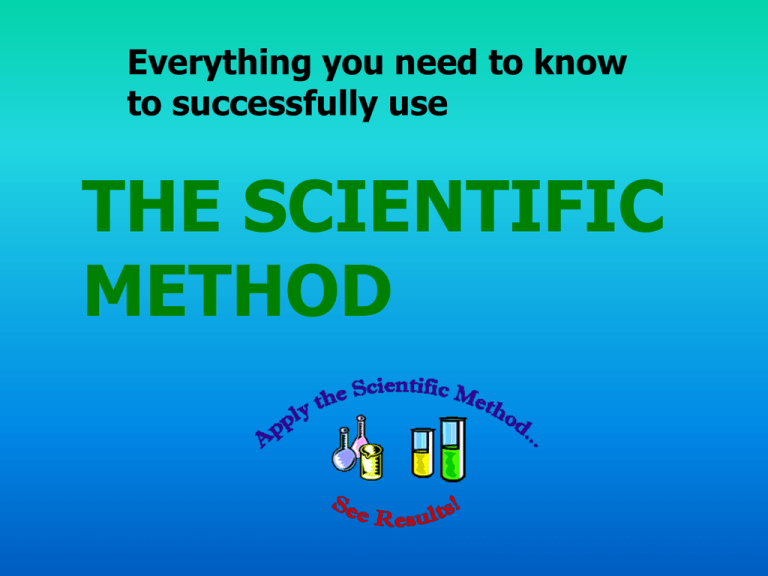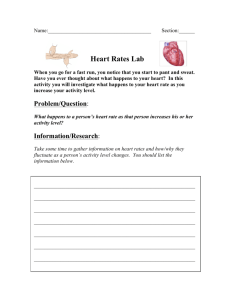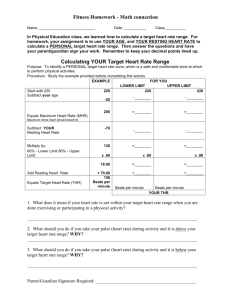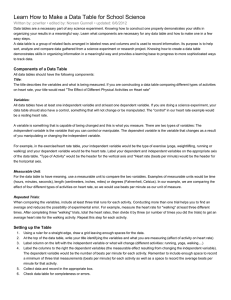scientific method ppt - Valhalla High School
advertisement

Everything you need to know to successfully use THE SCIENTIFIC METHOD First of all – WHY bother? The SM helps you organize your work. The SM helps you be able to repeat your work. The SM helps OTHERS be able to repeat your work. The SM helps you be sure to not forget anything. The SM helps make sure that you have a FAIR test. So where to begin – the RESEARCH QUESTION The RESEARCH QUESTION defines what you are doing – and what is being tested. It is written: What is the effect of ….. On …..? (a question ALWAYS ends in a ?) Now you know what you are testing and what you are measuring because . . . The research question actually says: What is the effect of the INDEPENDENT VARIABLE on the DEPENDENT VARIABLE? The Independent Variable (IV) is what you are testing – what YOU are changing in the test. The Dependent Variable (DV) is what you are MEASURING – and at BRMS you need to measure in numbers!! A good scientist always THINKS about what he or she is doing, so the next element is the HYPOTHESIS – an educated guess. You don’t need to do a lot of research to come up with your educated guess – you have to THINK about what you are doing and what might happen when you change the independent variable. A hypothesis CANNOT be considered wrong – but it can be stated incorrectly. A hypothesis is worded: I think IF……… THEN because ……… So now that you’ve given that some thought – it’s time to make sure that you CAN do the experiment. If you were baking chocolate chip cookies you would make sure that you have enough of each ingredient BEFORE you began the cookies – no point in getting started and not having enough chocolate chips!! Now you determine your list of MATERIALS –and you must be VERY SPECIFIC – tell us EXACTLY what you need to do this experiment. Your materials are written in list form to make it easier to read them. You also want to be sure that you understand what you are finding out – you need a CONTROL to be sure of what your experiment proves. The CONTROL is what you compare your results to. If you want to know what is the effect of different exercises (IV) on heart rate (DV) your control is the heart rate BEFORE you exercise. Think about 2 people exercising and each one raising their heart rate to 150 beats per minute. If one person’s heart rate STARTED at 100 that means that their exercise raised their heart rate 50 beats per minute. If another one started at 145 beats per minute their exercise only raised their heart rate 5 beats per minute. That’s a big difference. Which exercise had the most effect on the heart rates By comparing to the control you can tell. When performing an experiment you want to make sure that you have a FAIR and ACCURATE test. By keeping everything but the Independent Variable CONSTANT you can be sure that your test is fair. If you are testing the effect of different exercises you would want to make sure that you are testing the same age or sex of people, that they are in the same ‘shape’, that they are in the same environment, that they are wearing the same clothes and that the experiments are preformed the SAME WAY. You want to make sure that the control is clearly met before you do more exercises – or else your test is not fair. Once you have thought through ALL of those first steps: Research Question Hypothesis Independent and Dependent Variables Control Constants 1. Materials 2. 3. 4. 5. 6. You can decide HOW you will test and measure – and write out everything in your PROCEDURE. Procedures are written in list form – with numbers to help you follow the steps. BE SPECIFIC – someone else must be able to repeat your experiment EXACTLY by using your procedure. Your last step should always be to REPEAT and AVERAGE your results. If you can’t repeat you need to do LOTS of trials to get a fair test. Now perform your test – and MEASURE your results. And, organize and record your results in a DATA TABLE Data Tables have a TITLE – the same as your experiment!!! They have HEADINGS and UNITS that show what you learned. The CONTROL is always in the first row – that makes it easy to compare things to it. Make sure that you show all of your trials and the final average of your results Let’s look at a sample DATA TABLE: (Your hypothesis was that jumping jacks will raise the heart rate more than other exercises.) The effect of different exercises on heart rate. (The title can be a sentence.) Exercise Resting heart rate – beats per minute Heart rate after exercise – beats per minute CHANGE in heart rate – beats per minute Jumping jacks 120 165 45 1 mile jog 115 165 50 50 sit-ups 115 130 15 This table is missing a very important element – you must REPEAT your experiment and show the average of your trials. Check out the next slide for a more complete Data Table. The effect of different exercises on heart rate. Reported as beats per minute. Exercise Trial 1 – Trial 1 – Trial 1 resting heart rate change heart rate after in heart exercise rate Trial 2 – Trial 2 – resting heart rate heart rate after exercise Trial 2 change in heart rate Average change in heart rate The important thing to see here are the trials and the average results. It’s the average results that you will use as we continue. Data Tables are nice, but GRAPHS can SHOW your results in an easier to read way. Now you take your data and present it in a graph. You always present your AVERAGE results if you could do repeat trials – or else present all of the data you have. Graphs need the same title as your Data Table. They type of graph you use depends on what you measured – for example, a line graph shows change over time, a bar graph shows final results. Now that you have tested, measured, compared, and presented your data – WHAT DO YOU DO? This is the time when you DRAW A CONCLUSION – you look at your results and try to determine WHAT DID YOU FIND OUT? Your conclusion is written with 2 parts: WHAT DID I LEARN? HOW DOES THIS COMPARE TO MY HYPOTHESIS? You may also write about what you would do differently if you did the experiment again, and what others should know about doing the experiment. Now that you have tested, measured, compared, and presented your data – WHAT DO YOU DO? This is the time when you DRAW A CONCLUSION – you look at your results and try to determine WHAT DID YOU FIND OUT? Your conclusion is written with 2 parts: WHAT DID I LEARN? HOW DOES THIS COMPARE TO MY HYPOTHESIS? You may also write about what you would do differently if you did the experiment again, and what others should know about doing the experiment.







